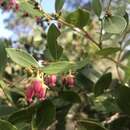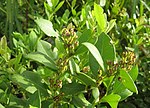fr
noms dans le fil d’Ariane


Lyonia lucida ist eine Pflanzenart aus der Gattung der Lyonien (Lyonia) innerhalb der Familie der Heidekrautgewächse (Ericaceae). Sie ist in den Küstenebenen der südöstlichen Vereinigten Staaten von Virginia bis nach Florida und Louisiana verbreitet und kommt auf Kuba vor.[1] Von der TNC wird Lyonia lucida als „ungefährdet“ („G5“) eingestuft.[2] Englischsprachige Trivialnamen sind fetterbush lyonia, hurrahbush, staggerbush; mit dem Trivialnamen „fetterbush“ werden auch Arten der Gattung Traubenheiden (Leucothoe)und der Gattung Pieris bezeichnet.
Lyonia lucida ist ein immergrüner Strauch mit Wuchshöhen von 4[1] bis zu 5[3] Metern und ebensolcher Breite. Sie bildet lange Rhizome, aus denen sich eine Kolonie bilden kann. Die Zweige besitzen eine schuppige Rinde.[1][3]
Die Laubblätter sind wechselständig angeordnet. Die ledrige, einfache Blattspreite ist bei einer Länge von bis zu 10,5 Zentimetern sowie einer Breite von bis zu 5,5 Zentimetern beispielsweise eiförmig.[3]
Der Blütenstand ist ein Faszikel. Die zwittrigen Blüten sind radiärsymmetrisch und fünfzählig mit doppelter Blütenhülle. Die Blütenkrone ist meist rosafarben, aber können auch weiß oder rot sein.
Falls eine Befruchtung erfolgt wird eine Kapselfrucht gebildet.[1][3]
Lyonia lucida vermehrt sich meist vegetativ, produziert aber auch Samen. Auf nährstoffarmen Böden blüht sie nicht und vermehrt sich dort ausschließlich vegetativ durch die Rhizome.[1]
Lyonia lucida ist eine häufige Art, die in verbuschten Mooren, feuchten Savannen, Nadelholz-Sümpfen und Strauchlandschaften vorkommt. Es gibt große Populationen in Sägepalmen-Prärien. Häufig ist sie im Okefenokee Swamp. Sie gedeiht auch in trockenen Lebensräumen, kommt jedoch normalerweise in Feuchtbiotopen vor, auch in zeitweilig überfluteten. Sie bevorzugt saure, wassergesättigte Böden mit hohem Humusgehalt, beispielsweise in Zypressen-Sümpfen. Sie kann im schattigen Unterholz überleben, bevorzugt jedoch sonnige Lebensräume.[1]
Zur Baumschicht dieser Lebensräume gehören Weiße Scheinzypresse (Chamaecyparis thyoides), Sumpf-Magnolie (Magnolia virginiana), Persea borbonia, Gordonia lasianthus, Tupelobäume (Nyssa spec.) und Kiefern (Pinus spec.). Der Unterwuchs besteht außerdem aus Arten wie Sommergrüner Traubenheide (Eubotrys racemosa), Amerikanischer Heidelbeere (Vaccinium corymbosum), Clethera alnifolia, Cyrilla racemiflora, Smilax laurifolia, Zenobia pulverulenta und Eichen (Quercus spec.).[1]
Lyonia lucida ist eine Pflanzenart aus der Gattung der Lyonien (Lyonia) innerhalb der Familie der Heidekrautgewächse (Ericaceae). Sie ist in den Küstenebenen der südöstlichen Vereinigten Staaten von Virginia bis nach Florida und Louisiana verbreitet und kommt auf Kuba vor. Von der TNC wird Lyonia lucida als „ungefährdet“ („G5“) eingestuft. Englischsprachige Trivialnamen sind fetterbush lyonia, hurrahbush, staggerbush; mit dem Trivialnamen „fetterbush“ werden auch Arten der Gattung Traubenheiden (Leucothoe)und der Gattung Pieris bezeichnet.
Lyonia lucida is a species of flowering plant in the family Ericaceae known by the common names fetterbush lyonia, hurrahbush, and staggerbush. Other plants may also be called fetterbush. This broadleaved evergreen plant grows on the coastal plain of the southeastern United States from Virginia to Florida to Louisiana. It also occurs in Cuba.[1]
This shrub can grow to 4[1] to 5[2] meters in height and just as wide. The plant has long rhizomes that can sprout up new plants, forming a colony. The leathery leaves are alternately arranged on scaly twigs. They are up to 10.5 centimeters long by 5.5 wide and are oval in shape. The inflorescence is a fascicle of cylindrical flowers which are usually pink but may be white or red. The fruit is a capsule.[1][2] The plant mostly reproduces vegetatively, but it also reproduces by seed. In soils poor in nutrients it does not flower and reproduces only by sprouting from the rhizome.[1]
This plant is a common species, growing in shrubby bogs, wet savannas, conifer swamps, and scrub. There are large populations in saw palmetto prairie habitat. It is common in the Okefenokee Swamp. It grows in dry habitat but it is usually found in wet places, including habitat that is periodically flooded. It prefers acidic, saturated soils rich in organic matter, such as those in cypress swamps. It may grow in shady understories but it does well in full sun. Overstory species in the habitat may include Atlantic white cedar (Chamaecyparis thyoides), sweet bay (Magnolia virginiana), red bay (Persea borbonia), loblolly bay (Gordonia lasianthus), tupelo (Nyssa spp.) and pines (Pinus spp.). It shares the understory with other plants such as sweetbells (Eubotrys racemosa), highbush blueberry (Vaccinium corymbosum), sweet pepperbush (Clethera alnifolia), titi (Cyrilla racemiflora), laurelleaf greenbrier (Smilax laurifolia), honeycup (Zenobia pulverulenta), and oaks (Quercus spp.).[1]
Lyonia lucida is a species of flowering plant in the family Ericaceae known by the common names fetterbush lyonia, hurrahbush, and staggerbush. Other plants may also be called fetterbush. This broadleaved evergreen plant grows on the coastal plain of the southeastern United States from Virginia to Florida to Louisiana. It also occurs in Cuba.
This shrub can grow to 4 to 5 meters in height and just as wide. The plant has long rhizomes that can sprout up new plants, forming a colony. The leathery leaves are alternately arranged on scaly twigs. They are up to 10.5 centimeters long by 5.5 wide and are oval in shape. The inflorescence is a fascicle of cylindrical flowers which are usually pink but may be white or red. The fruit is a capsule. The plant mostly reproduces vegetatively, but it also reproduces by seed. In soils poor in nutrients it does not flower and reproduces only by sprouting from the rhizome.
This plant is a common species, growing in shrubby bogs, wet savannas, conifer swamps, and scrub. There are large populations in saw palmetto prairie habitat. It is common in the Okefenokee Swamp. It grows in dry habitat but it is usually found in wet places, including habitat that is periodically flooded. It prefers acidic, saturated soils rich in organic matter, such as those in cypress swamps. It may grow in shady understories but it does well in full sun. Overstory species in the habitat may include Atlantic white cedar (Chamaecyparis thyoides), sweet bay (Magnolia virginiana), red bay (Persea borbonia), loblolly bay (Gordonia lasianthus), tupelo (Nyssa spp.) and pines (Pinus spp.). It shares the understory with other plants such as sweetbells (Eubotrys racemosa), highbush blueberry (Vaccinium corymbosum), sweet pepperbush (Clethera alnifolia), titi (Cyrilla racemiflora), laurelleaf greenbrier (Smilax laurifolia), honeycup (Zenobia pulverulenta), and oaks (Quercus spp.).

Lyonia lucida in fruit with capsules
Lyonia lucida là một loài thực vật có hoa trong họ Thạch nam. Loài này được (Lam.) K. Koch mô tả khoa học đầu tiên năm 1872.[1]
Lyonia lucida là một loài thực vật có hoa trong họ Thạch nam. Loài này được (Lam.) K. Koch mô tả khoa học đầu tiên năm 1872.